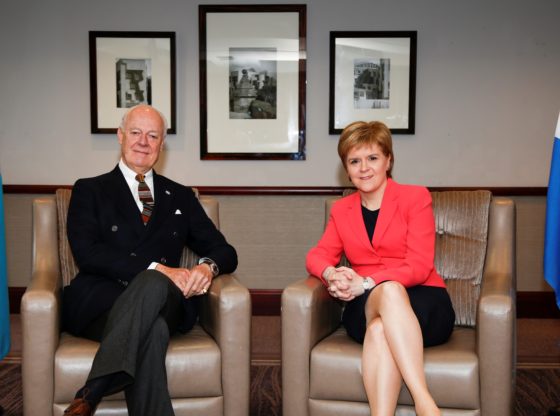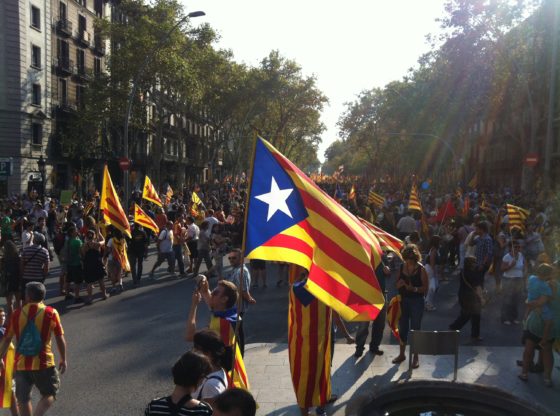Securing independence in 2011 has not brought stability to South Sudan. The country is beset by an array of challenges linked to its ongoing conflict. Michael McKean of Mercy Corps details those challenges and considers how his organisation’s work elsewhere may offer strategies which - even amidst conflict - can build confidence and cohesion among communities.
It is difficult to fathom that in 2017, in a world full of abundance, we see a litany of despair and hunger across our television screens. Not one but four nations have had declarations or warnings of famine in the last eight months. These nations - Nigeria, Somalia, South Sudan, and Yemen - all have something in common: they are experiencing long-term conflict and violence. And as the west is experiencing an obesity epidemic, for the first time this century, global hunger levels are rising.
The link between hunger and conflict has not always been so clear. According to the United Nations, only one-third of the countries in sub-Saharan Africa experiencing a food crisis in 1990 were also in the midst of a prolonged conflict. By 2010, this figure had grown to 80 percent. And war not only leads to food crises. War and conflict is the single biggest source of the fragility - defined as weak state capacity that leaves its citizens vulnerable to shocks - that we see in the world today. There is no greater risk to our lives, wherever we live.
War and conflict is the single biggest source of the fragility - defined as weak state capacity that leaves its citizens vulnerable to shocks - that we see in the world today.
As our attention has been drawn to the myriad of natural disasters that have wreaked havoc around the globe in recent weeks, we know that it is the man-made ones that are most deadly and difficult to resolve. Even as we work on climate change and respond to natural disasters we must, above all, end violence. And the two are not unrelated – competition for resources and climate-related displacement fuels conflict. It is impossible to manage a natural energy supply or improve water conditions in a country where war is raging. We cannot create any meaningful change without first ending violence.
SOUTH SUDAN
The country of South Sudan is number two on the Fragile States Index, which lists states’ vulnerability to conflict or collapse. It is the most dangerous place for aid workers to do their jobs, and is the source of the fastest-growing refugee crisis in the world. And earlier this year, the first famine in six years was declared in the country. It is easy to imagine South Sudan as a dry, hot, and barren country, but nothing could be further from the truth. In fact, a large part of the country has vast fertile lands with good rains and rivers. South Sudan’s famine was not caused by a natural disaster such as a drought: its root cause lies in violence and conflict.

Prior to 2005, South Sudan suffered from two decades of continuous civil war with Sudan, in which 2.5 million people died from violence, disease, and starvation. With the 2011 referendum and the subsequent independence of South Sudan, hope was high for a peaceful future. However, in December 2013, conflict broke out again. A political power struggle between President Salva Kiir and former Vice-President Riek Machar quickly took on ethnic undertones and deepened existing cleavages, mainly between the two largest groups in South Sudan – the Dinka and the Nuer. Implementing a ceasefire and peace deal has so far failed. Almost four years later, the country finds itself in the midst of a prolonged and catastrophic crisis once again.
While political solutions need to be found for the world’s wars, there is still much that international organisations and government donors working with communities can do to stem the tide of conflict and violence at the grassroots.
Despite $6.66 billion in humanitarian aid being provided to South Sudan between 2011 and 2015, the international community has been unable to prevent the country slipping back into conflict and reversing so much of the progress made. If South Sudan is going to have a hope of a peaceful and prosperous future, we need to begin to address the root causes of this conflict. While political solutions need to be found for the world’s wars, there is still much that international organisations and government donors working with communities can do to stem the tide of conflict and violence at the grassroots.

The crisis in South Sudan is characterised by the following conditions:
A deteriorating security situation: In 2016, the humanitarian crisis in South Sudan deepened and spread, exhausting the coping capacity of those already affected by years of conflict and underdevelopment. Notably, much of the insecurity people feel in their daily lives is due to inter- and intra-communal conflict characterised by cattle raiding and fighting over resources related to cattle (land and water) that has existed for decades. However, the armament of cattle camps by armed groups have increased death tolls as a result of raids. Many claim that peace cannot be achieved without addressing issues related to cattle.
Persistent and widespread displacement: More than three and a half million people have been forced to flee their homes since the conflict began in December 2013, including 1.9 million people who are internally displaced (with 50 percent estimated to be children) and two million people who have fled as refugees to neighbouring countries.
Unprecedented hunger: According to latest Integrated Phase Classification (IPC) report – the system set up to monitor food security – an estimated 1.7 million people are on the brink of starvation today in South Sudan and 6 million people (almost half the national population) are food insecure. The current levels of food insecurity are at the highest ever recorded in South Sudan.
Escalating economic crisis and hyperinflation: The fighting between and within ethnic groups has decimated the South Sudanese economy which has contracted by 15 percent. Ongoing conflict will cost the South Sudanese $28 billion if the crisis is not solved within the next five years.

LOOKING TO PREVIOUS STRATEGIES
In Ethiopia, Mercy Corps worked with pastoralist communities to resolve disputes non-violently though formal and informal mediation efforts. This helped these communities to better manage the tensions that arose between drought-affected pastoralist groups over natural resources, thus preventing escalation towards conflict. As a result, the communities concerned have become more resilient to climate shocks because they felt more secure, and freer to move around doing day-to-day activities such as planting or trading. A follow-up study confirmed this increase in peoples’ freedom of movement, critical in enabling communities to cope better in times of drought.
In 2012 in Uganda, we worked to improve food security in part by increasing the capacity of traditional authorities, elders, and women’s groups to reduce incidences of cattle rustling, land-related disputes, and other forms of conflict, and by improving linkages between informal systems and formal governance structures through meetings and dialogues. In 2015, it was found that there had been a clear improvement in security: this was especially noticeable through increased freedom of movement and fewer households reporting fear of engaging in work or other activities away from the home. Local leaders and government officials were regarded as being highly effective in preventing and resolving conflict.
We must learn from these experiences to tackle the root cause of conflict, which is driving the instability we see in many countries around the world. Communities, donor governments and organisations must work together to invest in grassroots conflict resolution skills and systems, increase community capacities, build stronger, trusting communities, and intervene early.
In South Sudan, beyond the larger political conflict, localised intercommunal conflicts are affecting people’s day-to-day security. It is these unresolved conflicts that have allowed political parties to mobilise support so easily in the current crisis. Even with a political solution, these intercommunal conflicts will remain unless we invest in managing the tensions and building social cohesion. Otherwise, we risk a re-emergence of conflict down the road. As the work above illustrates, we don’t have to wait for a national political solution to begin addressing local conflicts.
Michael McKean is Director of Programmes and Strategic Institutional Partnerships, Mercy Corps Europe.
Feature image: people celebrating South Sudan’s Independence Day in 2011. Image: Daniel X. O’Neil [CC BY 2.0]











